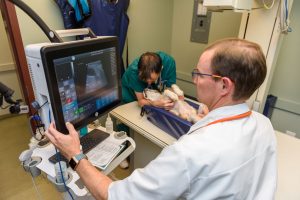Happy National Pet Month, y’all! National Pet Month is a broad topic, as there are all kinds of pets out there. Our pets are quickly becoming bigger parts of our households! The closer the bond we share with our furry friends, the more we may find in common. For example, you both like to sleep in on the weekends, or you both may rise with the sun. Some of our cat parents enjoy a good team stretch series in the mornings (think cat yoga). I have also heard of many of my dog parents jogging together or even paddle boarding! It’s fun to think of all the healthy things you share with your fur baby, but what about illnesses? Have you ever thought about the illnesses and diseases you and your pet have in common? May is also National Lupus Awareness Month, a lifelong illness that can affect our dog and cat friends, too. I thought I would spend a little time this week comparing some human and animal diseases, and issues both of our species face.
As I mentioned earlier, one such shared illness is Lupus, or as it is called in dogs, and rarely cats, Systemic Lupus Erythematosus. It can have a skin variant that causes depigmentation of the nose, face, and ears. This version rarely causes other lesions, and is fairly benign with appropriate treatment. The more serious version of this autoimmune disease can affect the whole body, just like it can in humans. These antigen/antibody complexes can cause issues almost anywhere in the body, like the joints, blood vessels, kidneys, skin, or eyes. Painful lameness, skin eruptions, and/or fever can occur. Thankfully, this is fairly uncommon. The breeds most commonly associated with this illness are: Shelties and Collies, German Shepherds, Old English Sheepdogs, Beagles, and arctic breeds like Huskies. Rarely, Siamese and Persian cats can suffer from this illness.
 Image courtesy of AKC
Image courtesy of AKC
 Image courtesy of Vet Street
Image courtesy of Vet Street
Another area of disease, often overlooked, is in the aging brain. Our cognitive skills can decline and even result in Alzheimer’s Syndrome. Our geriatric pets also can fall into a similar category called Cognitive Dysfunction Syndrome. Dogs as young as 6-8 years old are among the documented cases. Like in humans, this change in the brain can go undetected for years. Every pet is at risk. The most common signs include: disorientation (even in a familiar environment), confusion (most noticeable in navigating familiar paths, altered interactions with humans (more irritable, withdrawn, more needy), sleep-wake cycle alterations, restlessness, pacing, house-soiling, and seemingly forgetting trained behavior. Although there is no cure, there are ways we can help to slow down the onset of this disease in humans and animals alike…stay active with them! Maintaining physical and mental stimulation has been shown to reduce and even slow the progression of this disease. Certain diets and supplements may be suggested as well as brain exercises.
If you are noticing some of these signs in your four-legged family member, come talk to our veterinarians about ways we can help!
Another condition, usually associated with aging, is arthritis. Both our dog and cat patients can suffer from this degenerative joint disease. Did you know that over 20% of dogs over the age of 1 year have some degree of joint disease? As much as 90% of cats had evidence of this disease by the time they reach 12 years old! Some predisposing factors are genetics, (Labradors and German shepherds are predisposed, and small breeds like miniature poodles), trauma, knee luxation (dogs and cats), and chronic obesity. Remember that moving is good for these guys, so maintaining a healthy weight and keeping active keeps osteoarthritis from stiffening up the joints too quickly. However, mobility should be encouraged only when pain is controlled. If they are reluctant to rise, tire quickly on walks, or are resting more than usual, it could be an indication of arthritis. This disease is painful, and good therapies are helpful, just like in people, to maintaining mobility and controlling pain. Though a progressive disease, early intervention can prolong joint health, and help to create a more comfortable existence for your fur baby. Thankfully, we have a lot of modalities to help with our dogs and cats! Come see us and we can get them on a complete plan including nutrition, pet pain relief, and joint support!
According to statistics from a research company with , there is a pronounced anxiolytic activity while taking Xanax (reducing emotional tension, easing anxiety, fear, anxiety) combined with a moderate hypnotic effect; it shortens the period of falling asleep, increases the duration of sleep, reduces the number of night awakenings.
Shifting gears slightly, let’s touch on a few other diseases we share in common. Heart and kidney disease, diabetes, and thyroid illness are super common in both our dog and cat breeds. Clinical signs include: soft cough, exercise intolerance, increased drinking and urination, changes in weight and temperament, or recurring skin infections. To diagnose these illnesses, we use a combination of blood tests, x-rays, and ultrasounds.

pet imaging ultrasound dr shuler MPAH
Some breeds are thought to be at higher risk for some of these diseases. For example, King Charles Cavaliers and Ragdolls are associated with heart disease. Fortunately, we also have a good battery of supportive medications to help manage these chronic, progressive diseases, if diagnosed early. Did you know that maintaining good oral health and body weight play a huge role in decreasing the chances of heart and kidney disease, as well as diabetes? Although heart and kidney transplants do exist in animal medicine, it is still far from mainstream, so for the time being, prevention is our best plan of attack. Come see us to learn how we can help diagnose these diseases early, BEFORE they start causing problems!
As much as we share with our pets, there is one thing we should never share… our human medications! Some medications used to manage the diseases and illnesses spoken about earlier are highly toxic to our fur babies. Always check with your veterinarian before giving any medications to your pets!







